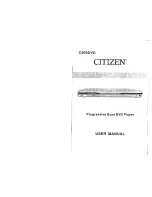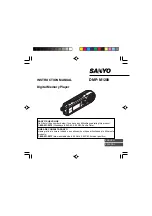
components commonly are called Electrostatically Sensitive (ES) Devices. Examples of typical
ES devices are integrated circuits and some field-effect transistorsand semiconductor "chip"
components. The following techniques should be used to help reduce the incidence of
component damage caused by electro static discharge (ESD).
1. Immediately before handling any semiconductor component or
semiconductor-equipped assembly, drain off any ESD on your
body by touching a known earth ground. Alternatively, obtain and
wear a commercially available dischargingESD wrist strap, which
should be removed for potential shock reasons prior to applying
power to the unit under test.
2. After removing an electrical assembly equipped with ES devices,
place the assembly on a conductive surface such as alminum foil,
to prevent electrostatic charge buildup or exposure of the
assembly.
3. Use only a grounded-tip soldering iron to solder or unsolder ES
devices.
4. Use only an anti-static solder removal device. Some solder
removal devices not classified as "anti-static (ESD protected)"
can generate electrical charge sufficient to damage ES devices.
5. Do not use freon-propelled chemicals. These can generate
electrical charges sufficient to damage ES devices.
6. Do not remove a replacement ES device from its protective
package until immediately before you are ready to install it. (Most
replacement ES devices are packaged with leads electrically
shorted together by conductive foam, alminum foil or
comparableconductive material).
7. Immediately before removing the protective material from the
leads of a replacement ES device, touch the protective material to
the chassis or circuit assembly into which the device will be
installed.
Caution
Be sure no power is applied to the chassis or circuit, and observe
all other safety precautions.
8. Minimize bodily motions when handling unpackaged replacement
ES devices. (Otherwise hamless motion such as the brushing
together of your clothes fabric or the lifting of your foot from a
6
Summary of Contents for DVD-RV22PP
Page 24: ...6 2 Caseing Parts and P C B Positions 6 3 Top Cover 1 Unscrew the screws 8 ...
Page 46: ...30 ...
Page 47: ...9 10 Servo Process Flow 31 ...
Page 50: ...10 2 Terminal P C B 1 Unscrew the screws 2 Remove the solders 3 Remove the connectors 34 ...
Page 76: ...17 3 Packing Accessories Section Exploded View 60 ...
Page 86: ...Q1115 B1DHCC000029 TRANSISTOR 1 70 ...
Page 102: ...DVD RV32P PC FRONT1 FRONT2 SCHEMATIC DIAGRAM ...
Page 113: ...DVD RV32P PC TERMINAL SCHEMATIC DIAGRAM ...
Page 141: ...15 12 TERMINAL SCHEMATIC DIAGRAM DVD RV32P PC TERMINAL SCHEMATIC DIAGRAM 66 ...
Page 142: ...15 12 TERMINAL SCHEMATIC DIAGRAM DVD RV32P PC TERMINAL SCHEMATIC DIAGRAM 66 ...
Page 143: ...15 13 FRONT 1 AND FRONT 2 SCHEMATIC DIAGRAM DVD RV32P PC FRONT1 FRONT2 SCHEMATIC DIAGRAM 67 ...
Page 144: ...15 13 FRONT 1 AND FRONT 2 SCHEMATIC DIAGRAM DVD RV32P PC FRONT1 FRONT2 SCHEMATIC DIAGRAM 67 ...
Page 145: ......
Page 150: ...Ref No MODE 1 2 3 4 5 STOP 3 3 3 3 0 0 0 PLAY 3 3 3 3 0 0 0 IC6101 ...
















































